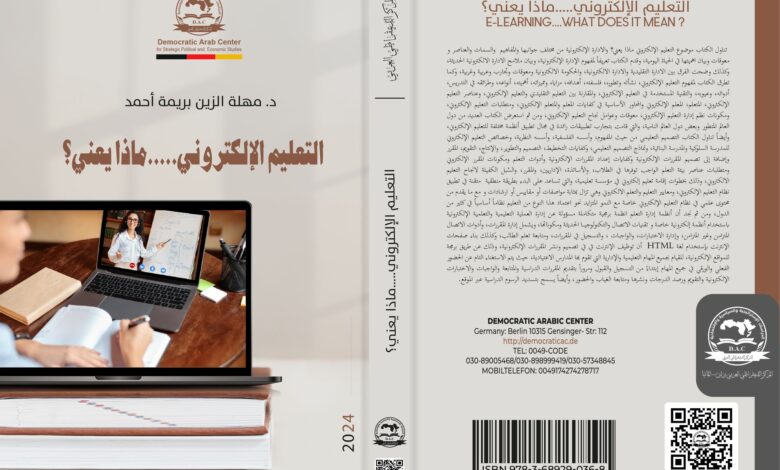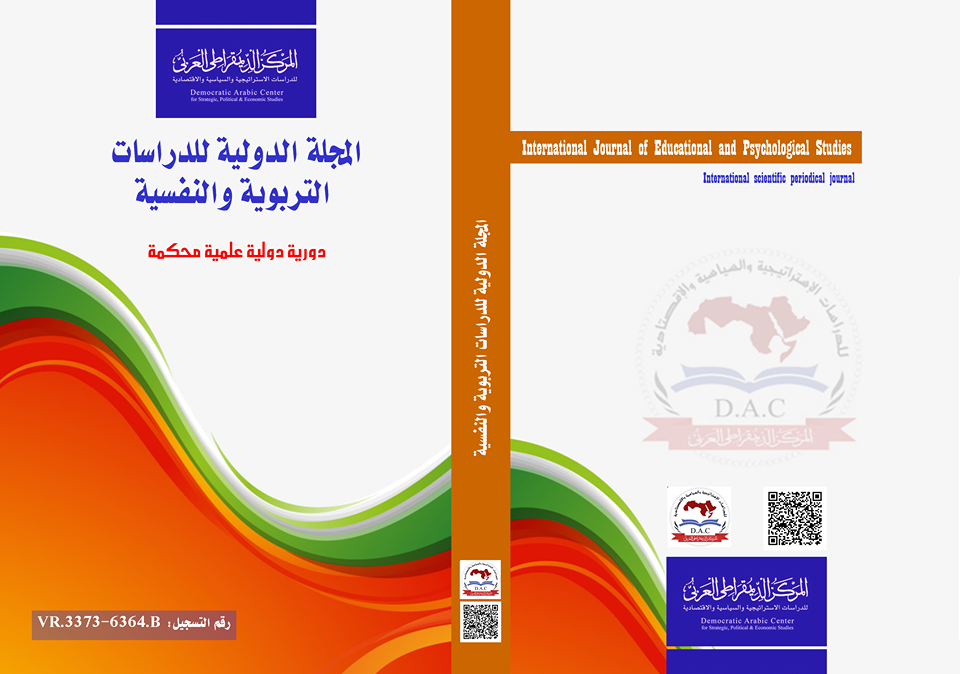
من أجل تأسيس التواصل والتفاعل بين الثقافات المختلفة وتشكيل مجتمع علمي يضم باحثين من المحيط إلى الخليج إضافة لمعالجة المشاكل الحضارية المشتركة.ضمن هذا السياق يسعدنا في #المركز_الديمقراطي_العربي (مؤسسة بحثية) ومقره ألمانيا – برلين اصدار كتاب في التعاون مع :-
- جامعة النيل الأبيض – السودان
- المجلة الدولية للدراسات الاقتصادية,دولية علمية محكّمة، تصدر عن #المركز_الديمقراطي_العربي ألمانيا – برلين
تأليف : د.مهلة الزين بريمة أحمد
تحميل نسخة pdf –
التعليم الإلكتروني – ماذا يعني ؟
الطبعة الأولى “2024″كتاب: – التعليم الإلكتروني – ماذا يعني ؟
جميع حقوق الطبع محفوظة : للمركز الديمقراطي العربي ولا يسمح بإعادة إصدار هذا الكتاب أو اي جزء منه أو تخزينه في نطاق إستعادة المعلومات أو نقله بأي شكل من الأشكال، دون إذن مسبق خطي من الناشر .
مقدمة : –
تناول الكتاب موضوع التعليم الإلكتروني ماذا يعني؟ والادارة الإلكترونية من مختلف جوانبها والمفاهيم والسمات والعناصر و معوقات وبيان اهميتها في الحياة اليومية، وقدم الكتاب تعريفاً لمفهوم الإدارة الإلكترونية، وبيان ملامح الادارة الالكترونية الحديثة، وكذلك وضحت الفرق بين الادارة التقليدية والادارة الالكترونية، والحكومة الالكترونية ومعوقات وتجارب وعربية وغربية، وكما تطرق الكتاب لمفهوم التعليم الإلكتروني، نشأته وتطوره، فلسفته، أهدافه، مزاياه ومميزاته، أهميته، أنواعه، وطرائقه في التدريس، أدواته، وعيوبه، والتقنية المستخدمة في التعليم الإلكتروني، والمقارنة بين التعليم التقليدي والتعليم الإلكتروني، وعناصر التعليم الإلكتروني، المتعلم، المعلم الإلكتروني والمحاور الأساسية في كفايات المعلم والمتعلم الإلكتروني، ومتطلبات التعليم الإلكتروني، ومكونات نظم إدارة التعليم الإلكتروني، معوقات وعوامل نجاح التعليم الإلكتروني، ومن ثم استعرض الكتاب العديد من دول العالم المتطور وبعض دول العالم النامية، والتي قامت بتجارب تطببيقات رائدة في مجال تطبيق أنظمة مختلفة للتعليم الإلكتروني، وأيضاً تناول الكتاب التصميم التعليمي من حيث المفهوم، وأسسه الفلسفية، وأسسه النظرية، وخصائص التعليم الإلكتروني للمدرسة السلوكية والمدرسة البنائية، ونماذج التصميم التعليمي، وكفايات التخطيط، التصميم والتطوير، والإنتاج، التقويم، المقرر وإضافة إلى تصميم المقررات الإلكترونية وكفايات إعداد المقررات الإلكترونية وأدوات التعلم ومكونات المقرر الإلكتروني ومتطلبات عناصر بيئة التعلم الواجب توفرها في الطلاب، والأساتذة، الإداريين، والمقرر، والسُبل الكفيلة لانجاح التعليم الالكتروني، وذلك بخطوات إقامة تعليم إلكتروني في مؤسسة تعليمية، والتي تساعد على البدء بطريقة منطقية متقنة في تطبيق نظام التعليم الإلكتروني، ومعايير التعليم والتعلم الالكتروني وهي تزال بمثابة مواصفات أو مقاييس أو ارشادات و مع ما يقدم من محتوى علمي في نظام التعليم الإلكتروني خاصة مع النمو المتزايد نحو اعتماد هذا النوع من التعليم نظاماً أساسياً في كثير من الدول، ومن ثم نجد أن أنظمة إدارة التعلم انظمة برمجية متكاملة مسؤولة عن إدارة العملية التعليمية والتعلمية الإلكترونية باستخدام أنظمة إلكترونية خاصة و تقنيات الاتصال والتكنولوجيــــا الحديثـة ومكوناتها، ويشمل إدارة المقررات، وأدوات الاتصال المتزامن وغير المتزامن، وإدارة الاختبارات، والواجبات ، والتسجيل في المقررات، ومتابعة تعلم الطالب، وكذلك بناء صفحات الإنترنت بإستخدام لغة HTML أن توظيف الإنترنت في في تصميم ونشر المقررات الإلكترونية، وذلك عن طريق برمجة للمواقع الإلكترونية، للقيام بجميع المهام التعليمية والإدارية التي تقوم بها المدارس الاعتيادية، حيث يتم الاستغناء التام عن الحضور الفعلي والورقي في جميع المهام إبتداءً من التسجيل والقبول ومروراً بتقديم المقررات الدراسية والمتابعة والواجبات والاختبارات الإلكترونية والتقويم ورصد الدرجات ونشرها ومتابعة الغياب والحضور، وأيضاً يسمح بتسديد الرسوم الدراسية عبر الموقع.
Abstract
The book dealt with the topic of E-learning, what does it mean? Electronic administration in its various aspects, concepts, features, elements, and obstacles, and an explanation of its importance in daily life. The book presented a definition of the concept of electronic administration, and an explanation of the features of modern electronic administration. It also clarified the difference between traditional administration and electronic administration, and electronic government, and its obstacles and experiences, Arab and Western. The book also touched on the concept of education. E-learning, its origins and development, its philosophy, goals, advantages and disadvantages, its importance, types, and methods of teaching, its tools and disadvantages, the technology used in e-learning, the comparison between traditional education and e-learning, the elements of e-learning, the learner, the e-teacher, and the basic axes of teacher competencies. The e-learner, e-learning requirements, components of e-learning management systems, obstacles and factors for the success of e-learning, and then the book reviewed many countries of the developed world and some countries of the developing world, which have experimented with pioneering applications in the field of applying different e-learning systems, and the book also dealt with design. Educational in terms of concept, its philosophical foundations, its theoretical foundations, the characteristics of e-learning for the behavioral school and the constructivist school, educational design models, the competencies of planning, design, development, production, evaluation, the course, in addition to the design of electronic courses, the competencies of preparing electronic courses, learning tools, the components of the electronic course, and the requirements for elements The learning environment that must be provided for students, professors, administrators, and the curriculum, and the ways to ensure the success of e-learning, through the steps of establishing e-learning in an educational institution, which helps to begin in a logical and elaborate manner in implementing the e-learning system, and the standards of e-learning and teaching, and they still serve as specifications or specifications. Standards or guidelines and the scientific content provided in the e-learning system, especially with the increasing growth towards adopting this type of education as a basic system in many countries. Hence, we find that learning management systems are integrated software systems responsible for managing the electronic educational and learning process using systems. Special electronic and communication techniques and modern technology and its components, and includes course management, synchronous and asynchronous communication tools, managing tests and assignments, registering for courses, and following up on student learning, as well as building Internet pages using the HTML language, employing the Internet in designing and publishing electronic courses, and that Through programming for websites, to carry out all the educational and administrative tasks carried out by regular schools, where physical and paper attendance is completely dispensed with in all tasks, starting from registration and acceptance, through submitting academic courses, follow-up, assignments, electronic tests, evaluation, monitoring and publishing grades, and following up on absence and attendance, and it also allows by paying tuition fees through the website.
الناشر: المركز الديمقراطي العربي للدراسات الإستراتيجية والسياسية والاقتصادية
Democratic Arabic Center- Berlin – Germany





